parking brake BUICK PARK AVENUE 1993 Owners Manual
[x] Cancel search | Manufacturer: BUICK, Model Year: 1993, Model line: PARK AVENUE, Model: BUICK PARK AVENUE 1993Pages: 340, PDF Size: 18.17 MB
Page 83 of 340
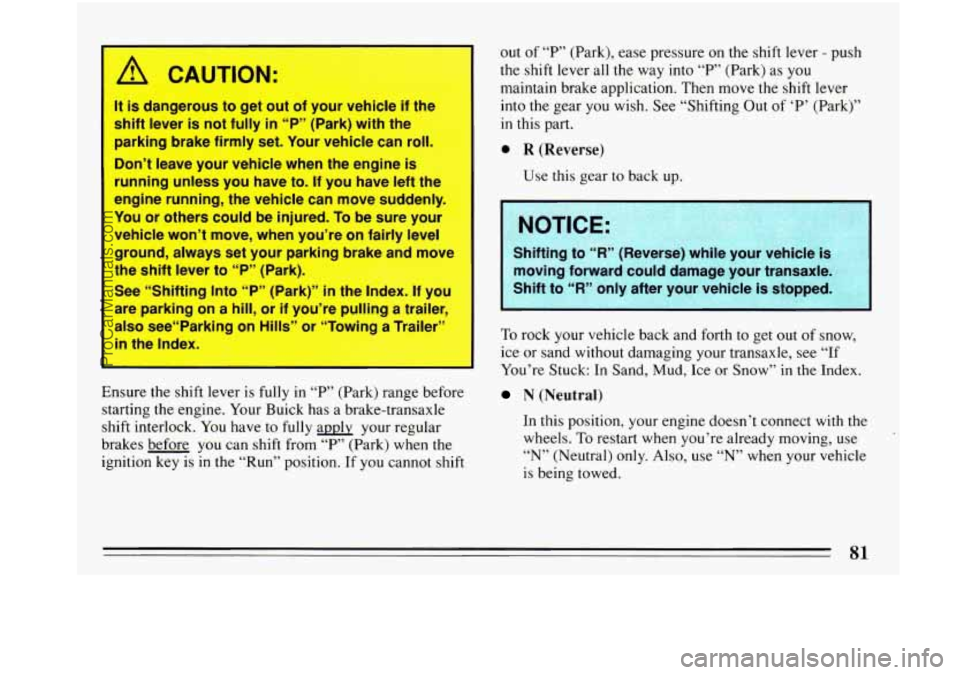
I A CAUTION:
It is dangerous to get out of your vehicle if the
shift lever is not fully
in “P” (Park) with the
parking brake firmly set. Your vehicle can roll.
Don’t leave your vehicle when the engine is
running unless you have to.
If you have left the
engine running, the vehicle can move suddenly.
You or others could be injured. To be sure your
vehicle won’t move, when you’re on fairly level
ground, always set your parking brake and move
the shift lever to “P” (Park).
See “Shifting Into “P” (Park)”
in the Index. If you
are parking on a
hill, or if you’re pulling a trailer
also see“Parking on Hills” or “Towing a Trailer’
in the Index.
Ensure the shift lever is fully in “P” (Park) range before
starting the engine. Your Buick has a brake-transaxle
shift interlock. You have
to fully apply your regular
brakes before you can shift from “P” (Park) when the
ignition key is in the “Run” position. If you cannot shift out
of
“P” (Park), ease pressure on the shift lever - push
the shift lever all the way into
“P” (Park) as you
maintain brake application. Then move the shift lever
into the gear you wish. See “Shifting Out
of ‘P’ (Park)”
in this part.
0 R (Reverse)
Use this gear to back up.
Shifting to ‘W’ (Reverse) while your vehicle is
moving forward could damage your transaxle.
Shift to
“R” only after your vehicle is stoppc
To rock your vehicle back and forth to get out of snow,
ice or sand without damaging your transaxle, see
“If
You’re Stuck: In Sand, Mud, Ice or Snow” in the Index.
N (Neutral)
In this position, your engine doesn’t connect with the
wheels.
To restart when you’re already moving, use
“N” (Neutral) only. Also, use “N” when your vehicle
is being towed.
ProCarManuals.com
Page 86 of 340
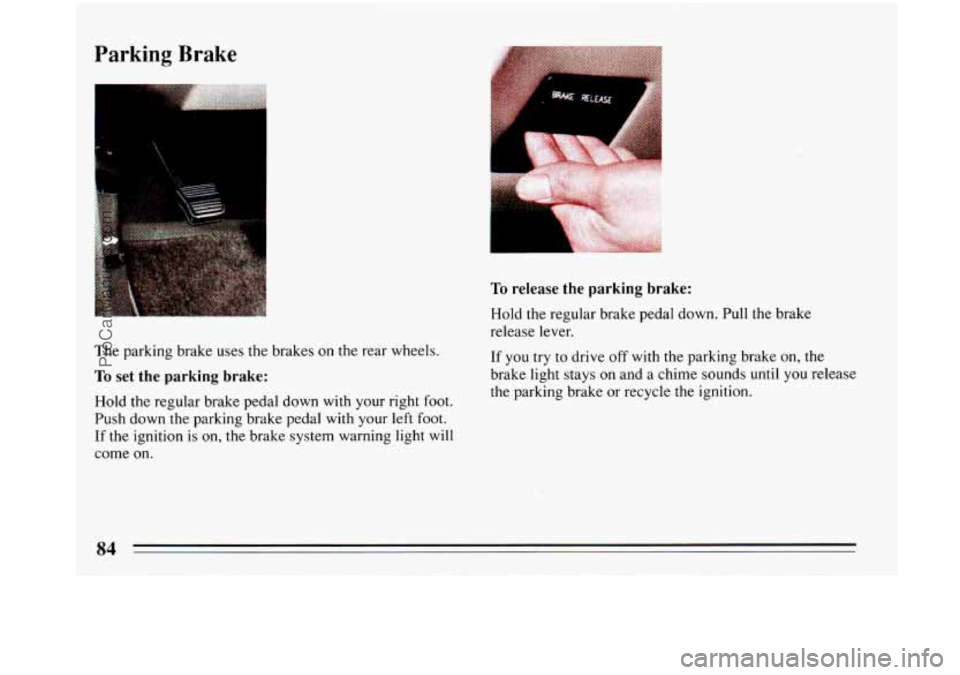
Parking Brake
The parking brake uses the brakes on the rear wheels.
To set the parking brake:
Hold the regular brake pedal down with your right foot.
Push down the parking brake pedal with your
left foot.
If the ignition
is on, the brake system warning light will
come on.
To release the parking brake:
Hold the regular brake pedal down. Pull the brake
release lever.
If you try to drive off with the parking braKe on, the
brake light stays on and a chime sounds until
you release
the parking brake or recycle the ignition.
ProCarManuals.com
Page 87 of 340
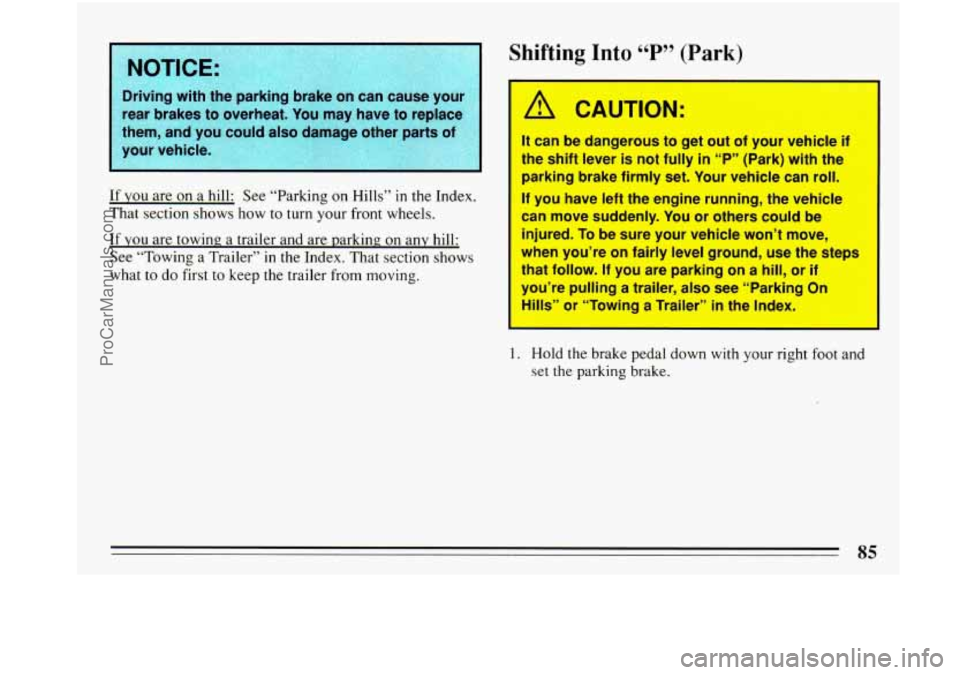
Driving with the parking brake on can cause youkz.,--.I
rear brakes to overheat.
You may have to replace-
them, and you could also damage other parts of
If YOU are on a hill: See “Parking on Hills” in the Index.
That section shows how to turn your front wheels.
If you are towing a trailer and are parking on any hill:
See “Towing a Trailer”
in the Index. That section shows
what
to do first to keep the trailer from moving.
Shifting Into “P” (Park)
A CAUTION:
It can be dangerous to get out of your vehicle if
the shift lever is not fully in “P” (Park) with the
parking brake firmly set. Your vehicle can roll.
If you have left the engine running, the vehicle
can move suddenly. You or others could be
injured. To be sure your vehicle won’t move,
when you’re on fairly level ground, use the steps
that follow.
If you are parking on a hill, or if
you’re pulling a trailer, also see “Parking On
H”‘ ;” or “Towing a Trailer” in the Index.
1. Hold the brake pedal down with your right foot and
set
the parking brake.
ProCarManuals.com
Page 89 of 340
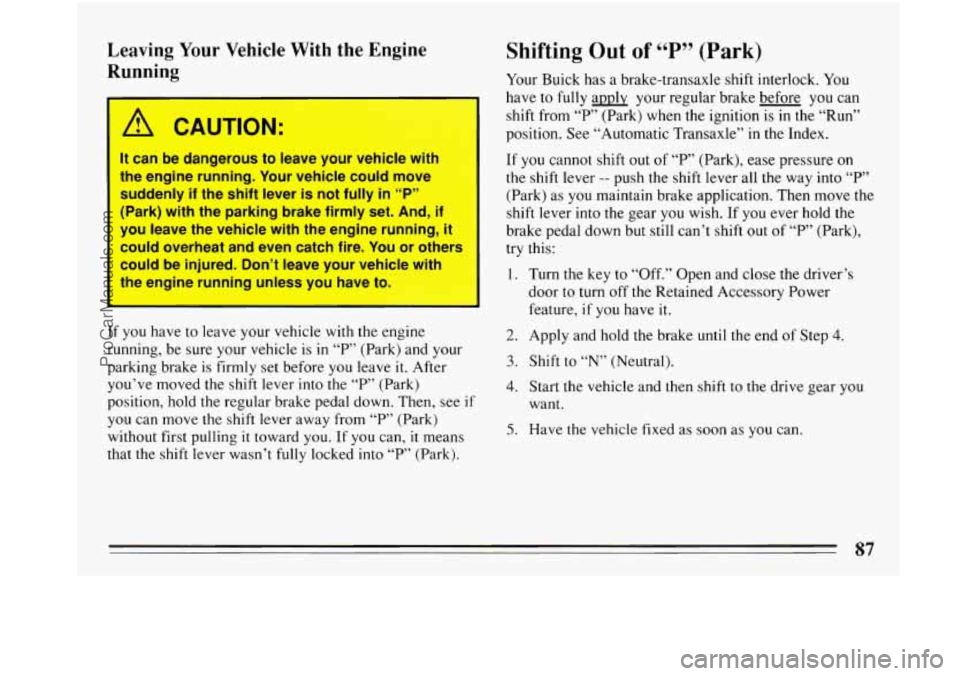
Leaving Your Vehicle With the Engine
Running
I
A CAUTION:
It can be dangerous to leave your vehicle with
the engine running. Your vehicle could move
suddenly
if the shift lever is not fully in “P”
(Park) with the parking brake firmly set. And, if
you leave the vehicle with the engine running,
it
could overheat and even catch fire. You or other3
could be injured. Don’t leave your vehicle with
the engine running unless you have to.
If you have to leave your vehicle with the engine
running, be sure your vehicle is in “P” (Park) and your
parking brake is firmly
set before you leave it. After
you’ve moved the shift lever
into the “P” (Park)
position, hold the regular brake pedal down. Then, see if
you can move the shift lever away from “P” (Park)
without first pulling it toward you. If you can, it means
that the shift lever wasn’t fully locked into “P” (Park).
Shifting Out of 46 P $9 (Park)
Your Buick has a brake-transaxle shift interlock. You
have
to fully apply your regular brake before you can
shift from “P” (Park) when the ignition is in the “Run”
position. See “Automatic Transaxle” in the Index.
If you cannot shift out of
“P” (Park), ease pressure on
the shift lever
-- push the shift lever all the way into “P’
(Park) as you maintain brake application. Then move the
shift lever into the gear
you wish. If you ever hold the
brake pedal down but still can’t shift out of “P” (Park),
try this:
I. Turn the key to “Off.” Open and close the driver’s
door to turn off the Retained Accessory Power
feature,
if you have it.
2. Apply and hold the brake until the end of Step 4.
3. Shift to “N” (Neutral).
4. Start the vehicle and then shift to the drive gear you
want.
5. Have the vehicle fixed as soon as you can.
87
ProCarManuals.com
Page 91 of 340

Running Your Engine While You’re
Parked
It’s better not to park with the engine running. But if you
ever have to, here are some things to know.
b!, CAUTION:
Idling the engine with the air system control off
could allow dangerous exhaust into your vehicle
(see the earlier Caution under “Engine Exhaust”).
Also, idling in a closeddn place can let deadly
carbon monoxide
(CO) into your vehicle even if
the fan switch
is at the highest setting. One place
this can happen is a garage. Exhaust -- with CO --
can come in easily. NEVER park in a garage with
the engine running.
-
Another closed-in place can be a blizzard. (See
“Blizzard” in the Index.)
CAUTION: (Continued)
CAUTION: (Continued)
It can be dangerous to get out of your vehicle if
the
shift lever is not fully in “Pyy (Park) with the
parking brake firmly set. Your vehicle can
roll.
Don’t leave your vehicle when the engine is
running unless you have to. If you’ve left the
engine running, the vehicle can move suddenly.
You
or others could be injured. To be sure your
vehicle won’t move, even when you’re on fairly
level ground, always set your parking brake and
move the shift lever to
“P” (Park).
Follow the proper steps to
be sure your vehicle
won’t move.
See “Shifting Into ’P‘ (Park)” in the
Index.
If you are parking on a hill, or if you’re pulling a
trailer, also see “Parking
on Hills” or “Towing a
Trailer”
in the Index.
ProCarManuals.com
Page 122 of 340
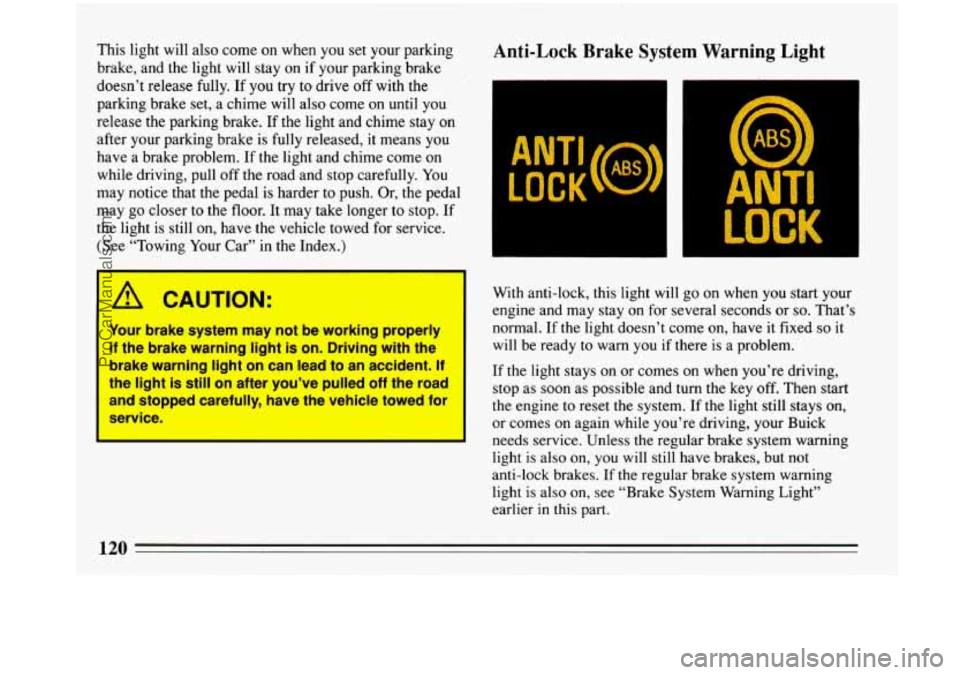
This light will also come on when you set your parking
brake, and the light will stay on if your parking brake
doesn’t release fully. If
you try to drive off with the
parking brake set, a chime will also come
on until you
release the parking brake. If the light and chime stay on
after your parking brake is fully released, it means
you
have a brake problem. If the light and chime come on
while driving, pull
off the road and stop carefully. You
may notice that the pedal is harder to .push. Or, the peda
may go closer to the floor. It may take longer
to stop. If
the light
is still on, have the vehicle towed for service.
(See “Towing Your Car” in the Index.)
I -
A CAUTION:
Your brake system may not be working properly
if the brake warning light is on. Driving with the
brake warning light on can lead to an accident.
If
the light is still on after you’ve pulled off the road
and stopped carefully, have the vehicle towed for
service.
1
Anti-Lock Brake System Warning Light
With anti-lock, this light will go on when you start your
engine and may stay on for several seconds or
so. That’s
normal. If the light doesn’t come on, have it fixed
so it
will be ready to warn
you if there is a problem.
If the light stays
on or comes on when you’re driving,
stop as soon as possible and turn the key
off. Then start
the engine
to reset the system. If the light still stays on,
or comes on again while you’re driving, your Buick
needs service. Unless the regular brake system warning
light
is also on, you will still have brakes, but not
anti-lock brakes.
If the regular brake system warning
light
is also on, see “Brake System Warning Light”
earlier
in this part.
ProCarManuals.com
Page 169 of 340
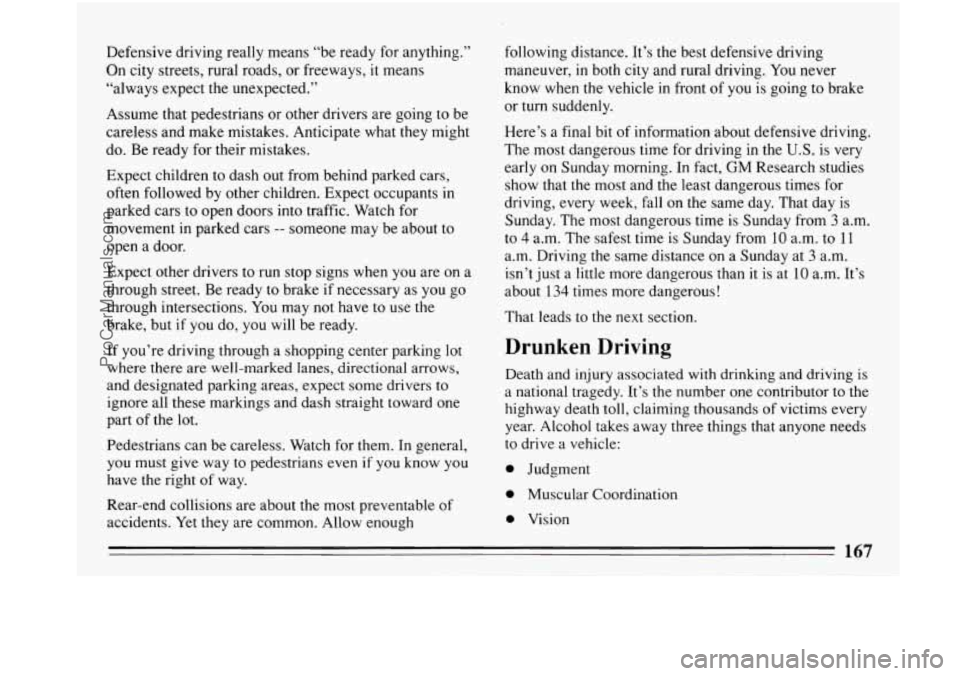
Defensive driving really means “be ready for anything.”
On city streets, rural roads, or freeways, it means
“always expect the unexpected.”
Assume that pedestrians or other drivers are going to be
careless and make mistakes. Anticipate what they might
do. Be ready for their mistakes.
Expect children to dash out from behind parked cars,
often followed by other children. Expect occupants in
parked cars to open doors into traffic. Watch for
movement in parked cars
-- someone may be about to
open a door.
Expect other drivers to run stop signs when you are on
a
through street. Be ready to brake if necessary as you go
through intersections. You may not have to use the
brake, but if
you do, you will be ready.
If you’re driving through a shopping center parking lot
where there are well-marked lanes, directional arrows,
and designated parking areas, expect some drivers to
ignore all these markings and dash straight toward one
part of the
lot.
Pedestrians can be careless. Watch for them. In general,
you must give way to pedestrians even if you know you
have the right of way.
Rear-end collisions are about
the most preventable of
accidents. Yet they are common. Allow enough following
distance. It’s the best defensive driving
maneuver, in both city and rural driving. You never
know when the vehicle in front
of you is going to brake
or
turn suddenly.
Here’s a final bit
of information about defensive driving.
The most dangerous time for driving in the
U.S. is very
early on Sunday morning. In fact,
GM Research studies
show that the most and the least dangerous times for
driving, every week, fall on the same day. That day is
Sunday. The most dangerous time
is Sunday from 3 a.m.
to
4 a.m. The safest time is Sunday from 10 a.m. to 11
a.m. Driving the same distance on a Sunday at 3 a.m.
isn’t just a little more dangerous than it is at
10 a.m. It’s
about
134 times more dangerous!
That leads
to the next section.
Drunken Driving
Death and injury associated with drinking and driving is
a national tragedy. It’s the number one contributor to the
highway death
toll, claiming thousands of victims every
year. Alcohol takes away three things that anyone needs
to drive a vehicle:
0 Judgment
0 Muscular Coordination
0 Vision
ProCarManuals.com
Page 187 of 340

A CAUTION:
Wet brakes can cause accidents. They won’t
work well in a quick stop and may cause pulling to one side. You could lose control
of the vehicle.
After driving through a large puddle
of water or a
car wash, apply your brake pedal lightly until
your brakes work normally.
Hydroplaning
Hydroplaning is dangerous. So much water can build up
under your tires that they can actually ride on the water.
This can happen if the road is wet enough and you’re
going fast enough. When your vehicle is hydroplaning,
it has little or no contact with the road.
You might not be aware of hydroplaning. You could
drive along for some time without realizing your tires
aren’t in constant contact with the road. You could find
out the hard way: when you have to slow, turn, move out
to pass
-- or if you get hit by a gust of wind. You could
suddenly find yourself out
of control.
Hydroplaning doesn’t happen often. But
it can if your
tires haven’t much tread
or if the pressure in one or more
is low.
It can happen if a lot of water is standing on the road.
If you can
see reflections from trees, telephone
poles, or other vehicles, and raindrops “dimple” the
water’s surface, there could be hydroplaning.
Hydroplaning usually happens at higher speeds. There
just isn’t a’hard and fast rule about hydroplaning. The
best advice is to slow down when it
is raining, and be
careful.
Some Other Rainy Weather Tips
0
0
0
0
0
Turn on your headlights -- not just your parking lights
-- to help make you more visible to others.
Look for hard-to-see vehicles coming from behind..
You may want
to use your headlights even in daytime
if it’s raining hard.
Besides slowing down, allow some extra following
distance. And be especially careful when you pass
another vehicle. Allow yourself more clear room
ahead, and
be prepared to have your view restricted
by road spray.
If the road spray is so heavy you are
actually blinded, drop back. Don’t pass until
conditions improve. Going more slowly is better than
having an accident.
Use your defogger
if it helps.
Have good tires with proper tread depth. (See
“Tires” in the Index.)
.,
ProCarManuals.com
Page 194 of 340
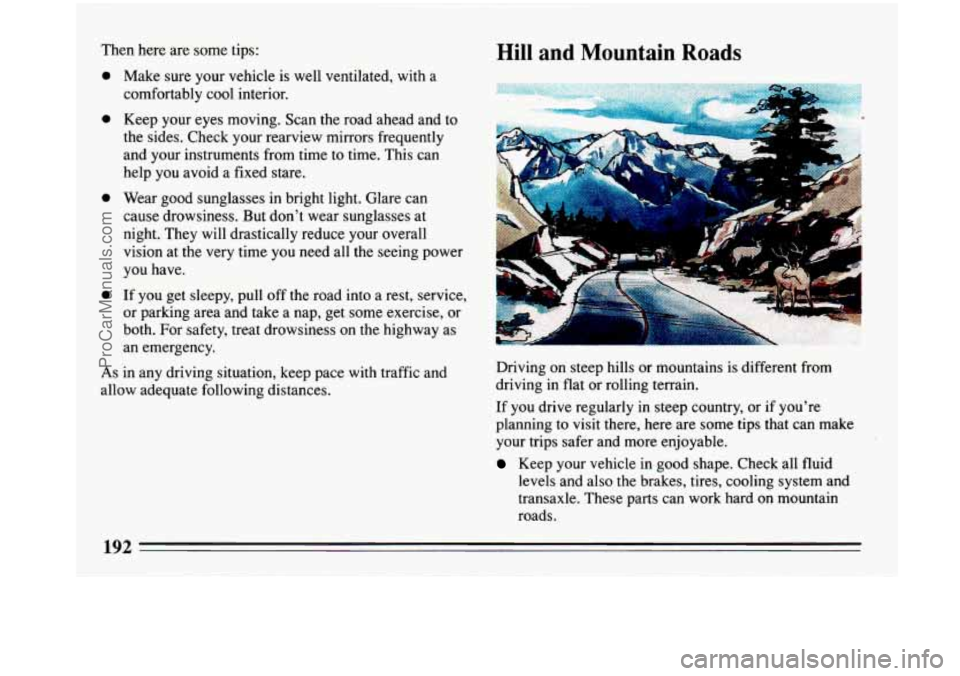
Then here are some tips:
e
e
e
e Make sure your vehicle is well ventilated, with a
comfortably cool interior.
Keep your eyes moving. Scan the road ahead and to
the sides. Check your rearview mirrors frequently
and your instruments from time
to time. This can
help you avoid
a fixed stare.
Wear
good sunglasses in bright light. Glare can
cause drowsiness. But don't wear sunglasses at
night. They will drastically reduce your overall
vision at the very time you need all the seeing power
you have.
If you get sleepy, pull off the road into a rest, service,
or parking area and take a nap, get some exercise, or
both. For safety, treat drowsiness
on the highway as
an emergency.
As in any driving situation, keep pace with traffic and
allow adequate following distances. Driving on
steep hills or mountains is different from
driving in flat or rolling terrain.
If you drive regularly
in steep country, or if you're
,planning to visit there, here are some tips that can make
your trips safer and more enjoyable.
Keep your vehicle in good shape. Check all fluid
levels and also the brakes, tires, cooling system and
transaxle. These parts can work hard
on mountain
roads.
192
ProCarManuals.com
Page 196 of 340
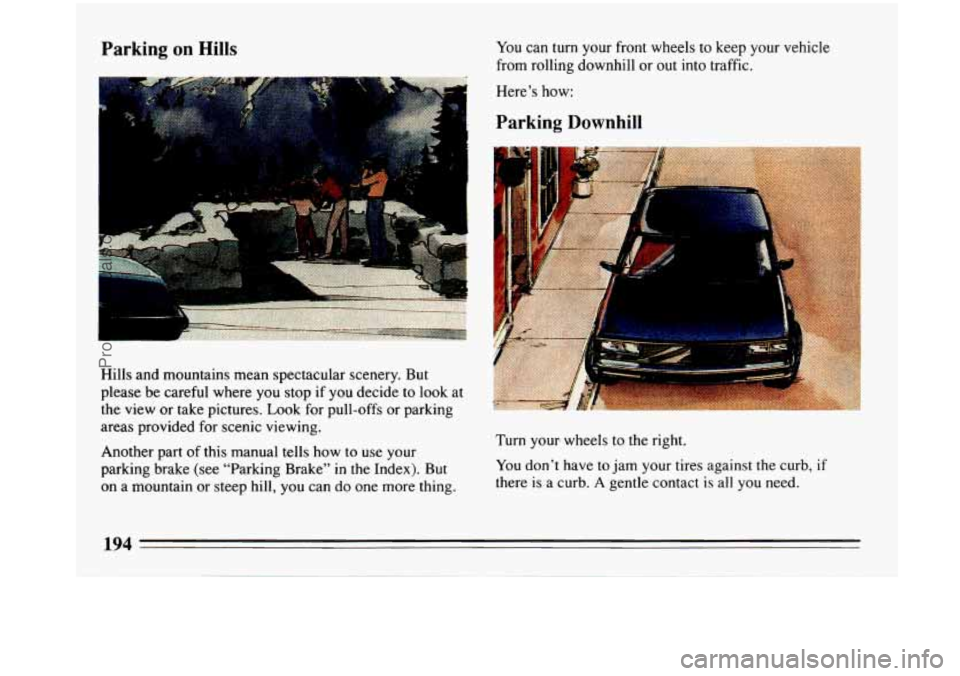
Parking on Hills
I
You can turn your front wheels to keep your vehicle
from rolling downhill or out into traffic.
Here’s
how:
Parking Downhill
Hills and mountains mean spectacular scenery. But
please be careful where
you stop if you decide to look at
the view
or take pictures. Look for pull-offs or parking
areas provided for scenic viewing.
Another part of this manual tells how
to use your
parking brake
(see “Parking Brake” in the Index). But
on
a mountain or steep hill, you can do one more thing. Turn
your wheels
to the right.
You don’t have to jam your tires against the curb, if
there is a curb.
A gentle contact is all you need.
694
ProCarManuals.com